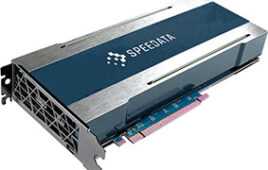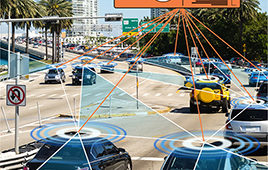CERN Purchases Multi-user Licenses for COMSOL Multiphysics
CERN, the European Organization for Nuclear Research and the world’s leading laboratory for particle physics, has purchased a multi-user license for COMSOL Multiphysics and a number of its add-on modules. Through this licensing agreement, this software is now available CERN wide for engineers and researchers. COMSOL Multiphysics enables them to conduct real-world simulations of any physics-based system during research, system design and development.
CERN is run by 20 European Member States, but many non-European countries are also involved, and scientists come from around the world to use CERN’s facilities. The Laboratory’s scientific and technical staff design and build particle accelerators and ensure their smooth operation; they also help prepare, run, analyze and interpret the data from complex scientific experiments. CERN has a permanent staff of 2500 researchers along with some 9500 visiting scientists who represent 608 universities and 113 nationalities.
“CERN attracts the world’s top scientists and researchers, and we are extremely gratified that these experts recognize COMSOL as one of the leading modeling codes and have asked to have CERN add this software to its arsenal of tools,” says Dr. Sven Friedel, Managing Director of COMSOL’s Zurich office, which handled the transaction. “This purchase clearly confirms the value of our software in assisting in the development and running of the world’s largest scientific experiments.”
From individual licenses to multi-user licenses
COMSOL has enjoyed a growing interest at CERN. Pierre Baehler, Manager of the CAD/CAE Support Team for the organization, notes that “the use of COMSOL products started in 2007 when one user purchased an individual license. He was very successful with it, his colleagues got interested in it and not long thereafter a few more licenses were acquired. Meanwhile, though, we see graduate students and researchers who have worked with COMSOL products at their universities coming to CERN for their research. Following an increasing number of requests from them and CERN researchers, our engineering software selection committee decided to purchase concurrent network licenses which allow a wider access to the tool. COMSOL clearly has the potential to become an important tool for engineering applications at CERN.”
“One aspect that makes COMSOL so attractive to these users is its flexibility,” so explains Bernardo Bordini, a researcher who previously used the software while at Fermilab (Chicago, IL) was also the first COMSOL license at CERN. “Here at CERN we’re dealing with very non-conventional problems. For instance, in my studies of the magneto-thermo stability of superconductors, we are pushing the Maxwell Equations into a very nonlinear region. We thus need to modify the standard equations, and COMSOL allows me to do exactly that. In addition, we strongly rely on the software’s multiphysics capabilities. For example in some of our systems where we are sending current from room ambient temperature into a cryogenic environment, we have to closely examine the interplay of heat transfer, structural dynamics and electromagnetic effects. It’s not easy to find other software that can do it this well”.
The multiphysics capabilities of COMSOL are also attractive to Rob Veenhof, who is a Convenor of the simulation group of RD51, an international consortium of 73 universities and research laboratories from 25 countries working on the study of gas-based detectors. Besides research, the group also conducts courses around the world that introduce simulation tools to PhD students and postdocs within the collaboration, and such a course was recently conducted at CERN.
Says Veenhof, “COMSOL is one of the finite-element packages we use to produce field maps that we then input into our own Garfield simulator. Further, COMSOL makes it far easier to study the onset of ‘streamers’. Here we work with some differential equations, which we can input directly into the software.” Veenhof adds that they are also studying very damaging gas discharges in the detectors and look forward to using the Plasma Module, which he now has access due to the new licensing agreement.
Yet another CERN experiment where COMSOL was of benefit is CMS, one of the particle detectors in the Large Hadron Collider, an underground particle collider with a circumference of 27 km. Here, Bertrand Baudouy of CEA (the French Atomic Energy Commission) used the software to help design the cryogenic cooling system that keeps the magnet of CMS at -269°C (4 K). Baudouy notes that “I can now design the cooling tubes for a superconducting magnet in a week or so, work that previously took two to three months.”
No limit on the number of cores
Returning to CERN’s decision to purchase the software, Pierre Baehler adds, “Another factor that was attractive was the fact that a single network license allows CERN to run a COMSOL job on any number of cores or a compute cluster. This contrasts to many other products with a per-core licensing scheme. Not having a limit to the number of cores is extremely convenient for us because we are constantly upgrading and expanding our compute resources. There’s no need to acquire more licenses, we can instead run the software on new hardware and make use of the full compute capacity as soon as the hardware is installed.”
COMSOL’s Friedel, who has been assisting CERN researchers in fully exploiting the software, summarizes the collaboration this way: “At CERN, the world’s leading researchers are pushing the state of the art in a number of disciplines and in modeling. It’s clear that COMSOL is a technology enabler that allows them to truly unleash their creativity. This fits in exactly with COMSOL’s culture of intensively working with its users to drive innovation on both sides. We look forward to seeing more CERN researchers joining our very active community.”
About CERN
CERN, the European Organization for Nuclear Research, operates the world’s leading laboratory for particle physics. Its business is fundamental physics, finding out what the universe is made of and how it works. Founded in 1954, CERN has become a prime example of international collaboration, with currently 20 Member States. Additional nations from around the globe also contribute to and participate in the research programs.
About COMSOL
COMSOL Multiphysics is a software environment for the modeling and simulation of any physics-based system. A particular strength is its ability to account for multiphysics phenomena. Optional modules add discipline-specific tools for mechanical, fluid, electromagnetics, and chemical simulations, as well as CAD interoperability. Founded in 1986, the company has U.S. offices in Burlington, MA, Los Angeles, CA, and Palo Alto, CA. International operations have grown to include offices in the Benelux countries, Denmark, Finland, France, Germany, India, Italy, Norway, Sweden, Switzerland, and the United Kingdom. Independent distributors of COMSOL Multiphysics are located in Australia, China, Egypt, Greece, Hungary, Israel, Japan, Korea, Malaysia, Poland, South Africa, the Czech Republic, Spain, Taiwan, and Turkey. Additional information about the company is available at www.comsol.com.




